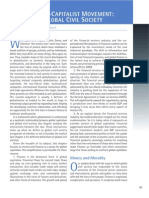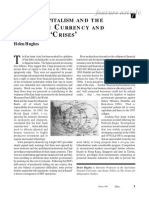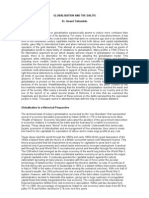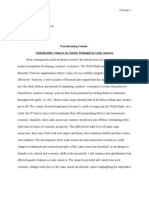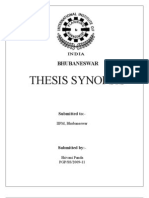Pettis 1996
Pettis 1996
Uploaded by
Daniel Victoriano BremontCopyright:
Available Formats
Pettis 1996
Pettis 1996
Uploaded by
Daniel Victoriano BremontOriginal Title
Copyright
Available Formats
Share this document
Did you find this document useful?
Is this content inappropriate?
Copyright:
Available Formats
Pettis 1996
Pettis 1996
Uploaded by
Daniel Victoriano BremontCopyright:
Available Formats
The Liquidity Trap: Latin America's Free-Market Past
Author(s): Michael Pettis
Source: Foreign Affairs, Vol. 75, No. 6 (Nov. - Dec., 1996), pp. 2-7
Published by: Council on Foreign Relations
Stable URL: http://www.jstor.org/stable/20047824 .
Accessed: 14/06/2014 09:50
Your use of the JSTOR archive indicates your acceptance of the Terms & Conditions of Use, available at .
http://www.jstor.org/page/info/about/policies/terms.jsp
.
JSTOR is a not-for-profit service that helps scholars, researchers, and students discover, use, and build upon a wide range of
content in a trusted digital archive. We use information technology and tools to increase productivity and facilitate new forms
of scholarship. For more information about JSTOR, please contact support@jstor.org.
Council on Foreign Relations is collaborating with JSTOR to digitize, preserve and extend access to Foreign
Affairs.
http://www.jstor.org
This content downloaded from 188.72.126.108 on Sat, 14 Jun 2014 09:50:23 AM
All use subject to JSTOR Terms and Conditions
The Liquidity Trap
Latin Americas Free-Market Past
Michael Pettis
The story iswell known in economics tional, corporatist economic dogmas and
lore: A famous academic, one of the their long history of poverty and eco
world's of deregula nomic to
leading proponents stagnation Anglo-Saxon-style
tion and free markets, is invited to Chile, competition and free markets.
which is in economic trouble. He and his These may sound like stories of modern
followers propose a series of measures to Latin America, but both are old. The
open the economy, including easing Chilean example does not refer to the
banking restrictions, freeing credit, and "Chicago boys" of the 1970s and 1980s,
nor does the Mexican
eliminating tariffs. Their prescriptions example describe
are followed, and, as foreign capital pours the Harvard-, Stanford-, and Columbia
in, the Chilean economy booms and be trained technocrats whom President
comes a model for the region. Or another Miguel de laMadrid Hurtado pushed for
version: InMexico the president turns ward in the mid-1980s. The foreign expert
the policies that have left the who so the Chileans was the
against beguiled
country heavily indebted and starved for French Jean Gustave
academic Courcelle
domestic investment. He places
a group Seneuil, one of Europe s
high priests of
of young economists and free-market who was invited to
foreign-trained capitalism,
in the trade and finance min Chile from 1855 to 1863 to advise the gov
engineers
istries, and they move rapidly
to free up ernment.
Among other reforms, his fol
areas of the economy and renegotiate lowers slashed tariffs in 1864 and even pri
key
Mexico's external debt. One of the most vatized the nitrate mines acquired
from
striking results of their reforms is a dizzy Peru in 1882during theWar of the Pacific.
ing rise in inflows of foreign capital. In The brilliant Mexican technocrats were
both cases
foreign journalists, the cient?ficos, a party of idealistic young
politicians,
and bankers praise the reforms for men who controlled key posts during the
spurring
a transformation: from tradi administration of President Porfirio D?az
Michael is a principal
Pettis of the Hamilton Arbitrage Fund in New
an of finance at Columbia Univer
York City and adjunct associate professor
sity's Graduate School of Business.
[2]
This content downloaded from 188.72.126.108 on Sat, 14 Jun 2014 09:50:23 AM
All use subject to JSTOR Terms and Conditions
The Liquidity Trap
in the 1890s. Under the expert guidance of American countries have enacted reforms
Jos? Y. Limantour, the sophisticated and aimed at
deregulation and a lowering of
forceful finance minister, their policies re trade barriers that is generally referred to
sulted in huge capital inflows,mostly into as the
Washington Consensus. Bankers
mining and railroad ventures, and a dra claim that, in contrast to this "new" model
matic increase inMexico s exports. of economic development, which the bulk
In neither case did the success last. of economists and financial journalists
The global crisis that swept through the have supported, the previous interven
United States and Latin America in late tionist
approaches?supposedly the norm
1873devastated Chile. As world commod in Latin America?were
proved
to be fail
ity prices fell, the Chilean economy col ures by the debt crisis of 1982 and the sub
a disaster exacerbated, economic contraction.
lapsed, according sequent long-term
to many historians, For example, Mexican
by Courcelle-SeneuiTs Finance Minister
free-market
policies. Fairly
or
unfairly, Guillermo Ortiz recently argued that
they argue that changes in the Chilean "turning the clock back is not an option.
banking laws led to the failure of the Going back to a closed economy or sta
currency and the abandonment tist or to our way
country's policies trying spend
of convertibility in 1878, that the 1864 tariff out of the recession have been tried be
reduction brought about the destruction fore, in this country and elsewhere, and
of domestic industry, and that privatiza haven't worked." Even after the De
they
tion concentrated
ownership among a cember 1994 peso crisis inMexico, criti
small group of Chileans and foreigners. cism was directed not at the
Washington
InMexico in the 1890s, thewealth of Consensus but at violations of it.
leading businessmen
skyrocketed, work But it is not just the statist models
ers' wages stagnated, and poverty among that have not worked. Latin American
farmers and farm workers rose. Local countries have long histories of periodic
banks had written too many loans to those enthusiasms for reforming the economy
who were connected or who to sound academic
politically according theory and
on real estate or securities, and for importing The most
speculated foreign experts.
when the international market had a famous of these was the American econ
peri
odic downturn, the banking system col omist EdwinKemmerer, the "money
lapsed.The crisis following the 1907 global doctor," who from the 1890s to the 1920s
contraction was so severe that even mem market reforms for about a
prescribed
bers of the elite turned against Diaz. dozen Latin American countries. His
When the president used the crisis as a recommendations were demolished by
excuse for on a to the Great and remained out
partial reneging promise Depression
return to it threw the country of fashion until they were resurrected
democracy,
into a period of political instability that in the 1980s.
ended with the start of more than ten
CAPITAL TIDES
years of revolution and, in 1913, a suspen
sion of payments on the external debt. The in Latin America's economic
pattern
The with the recent past are not seem to
parallels history does change much.
striking. Over the last decade Latin Whenever Latin countries have embarked
FOREIGN AFFAIRS -November/December 1996 [3]
This content downloaded from 188.72.126.108 on Sat, 14 Jun 2014 09:50:23 AM
All use subject to JSTOR Terms and Conditions
Michael Pettis
on programs of deregulation and free booms had
previous collapsed during
markets, and commodity were contractions, this time
prices global monetary
high and global liquidity was abundant, with the sharp contraction engineered
the response of the local economy was during the Carter administration.
usually positive and sometimes miracu Why do these booms occur? Probably
lous. There's the rub: if commodity because in times of great liquidity, in
prices were high and global liquidity was vestors' tolerance for risk grows enor
abundant. When these conditions were
mously and high-risk projects with high
reversed, the same countries that eagerly returns are flooded with
expected capital.
embraced sound economic are in poorer coun
theory found When these projects
con tries, the capital influx can easily set off a
themselves by economic
devastated
tractions and defaulted on the
foreign self-fulfilling local boom. Latin America
loans that had financed the expansion. is growing, but over the past five years it
All Latin American booms have had in has had a large capital inflow?it took in
common the conditions of excess global $201 billion of private capital in 1995
liquidity resulting in capital inflows, and alone and $182 billion the year before.
high or stable commodity prices.Whether This
history suggests that when
the regime was pro-market or interven amounts of capital flow into Latin
large
tionist seems to have mattered less. America, the result is an investment
While economists identify reforms
as boom that causes a
spurt of economic
the chief determinant of economic suc however, that has
growth?growth,
cess, history suggests awider set of forces. never been sustainable. It may suggest
In the 1860s a Latin American further that bankers are naive to assume
lending
boom occurred when English and French that a combination of a new market ori
capital poured into awide
variety of risky entation among the political elite, re
foreign investments, including shady rail ducing market barriers and failures, and
road stock and the bonds of an effectively increased credibility will pull these
kh?dive of Egypt. Another oc countries out of the of poverty and
bankrupt cycle
curred in the 1880s, when the passion for underdevelopment. wider political
Only
investment included Ponzi schemes and can broaden the benefits of
participation
Florida swamps. In the 1920s, the liquid growth and, when the next
liquidity crisis
ity generated by German reparations comes, prevent popular backlash and de
payments and the Federal Reserve's 1927 fault on the debt. Nor should some diver
of U.S. monetary conditions to gence from theWashington Consensus
easing
help the British return to the gold stan be regarded as backsliding.
dard helped spur both aWall Street stock
market rally and the huge capital inflows NO SAVING GRACE
of the Latin American "dance of the mil The bankers who tout the current round
lions." Forty years later the lending wave of reforms as a real break with the past
to countries took place argue that they will result in
less-developed usually
because commercial banks were eager to higher domestic savings
rates in Latin
the vast petrodollar flow. It col America. Once the savings at home are
recycle
lapsed at the end of the decade, just as sufficient to
replace foreign investment,
[4] FOREIGN AFFAIRS ysNo. 6
-Volume
This content downloaded from 188.72.126.108 on Sat, 14 Jun 2014 09:50:23 AM
All use subject to JSTOR Terms and Conditions
The Liquidity Trap
the argument goes, the regions econo
mies will be uncoupled from international
to achieve the
capital and able growth
rates of the Asian a
tigers. But there is
here too. The in the sav
problem growth
ings
rate is not uniform among these na
tions, nor is it sustainable. Furthermore,
increased may be an effect, not a
savings
cause, of improved economic performance,
and they could dry up in a significant
economic downturn.
Most important, since free capital flows
are part of the Consensus
Washington
it is not clear that higher domestic
package,
rates will in greater
savings always result
domestic investment. High savings, gener
ally produced by savvy upper and upper
middle classes, can fuel capital flight. Pre
a finance
liminary work by Michael Adler,
at Columbia University, suggests
professor
that domestic investment inArgentina
has a closer correlation to
foreign capital
inflows than to the national rate.
savings
Argentine savings tend to accumulate in
offshore accounts and behave like foreign
hot money. If Adler is right, then domes
CULVER PICTURES/HARPER'S WEEK]
tic savings, rather than cushioning domes
tic investment from the volatility of inter Latin America, take your medicine.
national capital flows, may actually
exacerbate to force
volatility. Attempts
into strictly describes as of "heavy state inter
savings regulated pension periods
funds will not necessarily solve the prob ventionism, inward
orientation, and dis
lem, since in times of trouble local gov regard for macroeconomic balance."
often treat pools of domestic cases are to include
ernments These usually defined
as for pur the import substitution of the 1960s and
savings piggy banks available
poses other than prudent investments. 1970s, Brazil in the 1930s and 1960s, the
Confidence in theWashington Con early American Popular Revolutionary
sensus be merited if the growth Alliance in Peru in the late 1950s, and
might
spurts in Latin America had occurred Argentina under Juan Peron (1946-55 and
were exper have experi
only when local governments 1973-74). Even these regimes
with free-market enced intervals of rapid growth before
imenting philosophies,
and not two years after the
during what Sebastian Edwards, breaking down. Brazil,
one of the theorists of the new consensus, 1964 military coup that brought with it a
FOREIGN AFFAIRS- November/December 1996 [5 ]
This content downloaded from 188.72.126.108 on Sat, 14 Jun 2014 09:50:23 AM
All use subject to JSTOR Terms and Conditions
Michael Pettis
nationalist and corporatist ideology, tion that led to the reversal of reforms.
began
a
period of extraordinary growth During the bursts of rapid growth attrib
celebrated as the "Brazilian miracle." utable to inflows, as the
large capital
Mexico during much of the reign of Jos? dominant groups grab a disproportionate
L?pez Portillo in the 1970s posted im share of the benefits, the rest of the coun
pressive
economic numbers when it tried try cannot absorb the inevitable external
the now-discredited substitution shocks?a or of
import capital shortage collapse
model. But, like the free-market regimes, commodities prices. The middle and
these alternatives invariably produced dis lower-middle classes that suddenly emerge
appointing results. during boom periods lose everything in
the bust. Given these groups' subsequent
THE WESTERN MODEL to the economic
antipathy regime and the
not that that economic of the local elites to share
The point is pol unwillingness
does not matter or that there is no power, it is not surprising that the prevail
icy
success in Latin system is almost never able
hope for
economic ing economic
America. Rather it is that the current re to outlive a
major external shock.
forms are not at all new and that histori If free markets have not worked in the
not led to sustainable past, how should Latin American
cally they have policy
economic growth. Long-term growth makers proceed? The nineteenth-century
may have more to do with political
mat United States is often held up as an eco
uration and democracy. Ironically, the nomic model for Latin America, but its
of President Ernesto backers a of
democratizing goals depict mythical country
Zedillo Ponce de L?on may do more for laissez-faire capitalism, orthodox mone
Mexico's economic prospects than will tary policies, and free trade, whose citi
the determination of his predecessor, zens toward sectors
naturally gravitated
Carlos de Gortari,
Salinas to open the where was fastest.
productivity growth
economy. This a
is much-argued This leaves out the government's
point, picture
since in the short term the correlation important role in promoting manufactur
between democracy and rapid growth ing, digging canals, subsidizing nearly all
may not be very strong. But the fact re the railroads, and, above all, protecting
mains that the only countries that have domestic manufacturers from competi
achieved sustained economic are tion with the much more
growth productive
those inwhich political power and par English. Of allmajor countries in the
ticipation arewidely distributed. second half of the nineteenth century,
In Latin America, the econ the United States was the least open to
opening
and sound has too international trade. In fact, one of the
omy keeping money
often increased the value of assets at the most causes of the Civil War
important
was the trade policy conflict between the
expense of real wages, coupled with
promises
of future relief once the economy free-trading South, which was content
takes off. But without robust mechanisms to export commodities and import man
for sharing power and economic benefits, ufactured goods, and the protectionist
all previous bouts of liberal economic re North, which was determined to pro
form have run up mote domestic
against popular opposi manufacturing.
[6] FOREIGN AFFAIRS-VolumeysNo.6
This content downloaded from 188.72.126.108 on Sat, 14 Jun 2014 09:50:23 AM
All use subject to JSTOR Terms and Conditions
The Liquidity Trap
Latin American policymakers about the region's prospects, but given
Perhaps
should study the efforts of the brilliant the strongwill there and in theUnited
of the States to see economic success south of
eighteenth-century Secretary
Hamilton to convert the border, be tragic if the cur
itwould
Treasury Alexander
theUnited States, a nation of squabbling rent
period proved just
one more failed
into a at are
farmers and corrupt politicians, attempt catch-up. World markets
major economic force. Under the going through another cycle of abundant
Hamiltonian system, sustainable
growth liquidity, and fundswill continue to flow
was the result of a and un into the emerging markets for many
pragmatic
orthodox combination of a reasonably more years, leading to bursts of growth
focused in many parts of Latin America. It would
infant-industry policy, protection
of high-productivity growth areas of the be foolish, however, to confuse this
economy, fairly intense domestic compe growth with the success of theWashington
tition, and free capital flows. Like Latin Consensus. Bankers generally agree on the
America more the United States correct course for Latin America, but local
recendy,
in the nineteenth century suffered severe authorities should not put too much faith
economic fluctuations tied to changes in in their advice.?
global liquidity, but these took place in a
nation where political power was widely
shared and where movements
populist
were able to capture power
regularly
democratically and seize a portion of
the economic benefits.
Since the benefits of the recent
in Latin America have not been
A Global Ethic
growth
widely distributed, international bankers The Leadership Challenge
should insist on a rigorous, even zeal
not
By Dr. William Hitt
ous, free-market orthodoxy that imposes i:iliic "Hitt has created more
a burden on the poor. Bankers continue than a philosophy of
to argue that such reforms will leadership. He has set
bring
long-term growth and are too willing to forth a philosophy of life
near
that seems veryright for
tolerate income inequality in the "
a complex world.
term. Without real popular political par
David C. Smith, President,
ticipation, economic growth has rarely Council for Ethics in Economics
helped the poor. Global liquidity will Written for leaderswho work in the international
contract in community, A Global Ethic identifies the need for a
inevitably again?perhaps core set of values tobe used by the emergingworld
this decade?and if the past is any indi community. Hitt defines this ethic and describes its
cator, Latin American economies will role in organizational leadership.
$20.00 +$3.50 shipping ISBN 1-57477-016-0
suffer disproportionately.Without popular
Contact Bartelle Press to order: 800-451-3543
support, currendy fashionable reforms
614-424-6393
will not survive. BATTELLEPRESS
Latin America's historical record is
?? 505 King Avenue Columbus. Ohio 43201
http://www.battelle.com
bleak, and it is difficult to be optimistic
FOREIGN AFFAIRS -
November/December 1996 [7]
This content downloaded from 188.72.126.108 on Sat, 14 Jun 2014 09:50:23 AM
All use subject to JSTOR Terms and Conditions
You might also like
- Kingdon A Model For Agenda SettingDocument7 pagesKingdon A Model For Agenda SettingMadai UrteagaNo ratings yet
- GR 157584 Garcia V Exec. SecDocument3 pagesGR 157584 Garcia V Exec. SecVergelGerona100% (1)
- Critical Sociology: The Chilean "Economic Miracle": An Empirical CritiqueDocument17 pagesCritical Sociology: The Chilean "Economic Miracle": An Empirical CritiqueSteve RothschildNo ratings yet
- Local Goverment and Regional AdministrationDocument31 pagesLocal Goverment and Regional AdministrationJessie Jean Condez Mangilaya67% (3)
- Mundialización Del Capital y Crisis Del Desarrollo Nacional - Sweezy, P.Document7 pagesMundialización Del Capital y Crisis Del Desarrollo Nacional - Sweezy, P.Nandy CautivoNo ratings yet
- Edwards 2008 Globalisation, GrowtDocument18 pagesEdwards 2008 Globalisation, GrowtAdry CMNo ratings yet
- The Sinking of World Economy - Trade Insight 2010Document1 pageThe Sinking of World Economy - Trade Insight 2010Chandan SapkotaNo ratings yet
- Unit IV. Classic Theories of Economic Growth and DevelopmentDocument19 pagesUnit IV. Classic Theories of Economic Growth and DevelopmentCatrina Joanna AmonsotNo ratings yet
- Rev PRE - WW Rostow - The Stages of Growth - 160812Document74 pagesRev PRE - WW Rostow - The Stages of Growth - 160812HBNo ratings yet
- trade v aidDocument4 pagestrade v aidDreamyNyxNo ratings yet
- Sweezy, P. M. (1994) - The Triumph of Financial Capital. Monthly Review-New York, 46, 1-1.Document5 pagesSweezy, P. M. (1994) - The Triumph of Financial Capital. Monthly Review-New York, 46, 1-1.lcr89No ratings yet
- MacroDocument8 pagesMacrokanavyadav62No ratings yet
- Classical Growth ModelDocument8 pagesClassical Growth ModelFouad AminNo ratings yet
- ECD1 2ingDocument38 pagesECD1 2inggabyakameNo ratings yet
- The Twilight of Chimerica'? China and The Collapse of The American ModelDocument9 pagesThe Twilight of Chimerica'? China and The Collapse of The American Modelricky1011No ratings yet
- Neoliberalism in ChinaDocument21 pagesNeoliberalism in ChinaGarvit ChaudharyNo ratings yet
- Chapter 1Document75 pagesChapter 1CharleneKronstedtNo ratings yet
- Import Substitution Industrialization PDFDocument28 pagesImport Substitution Industrialization PDFAdrixDuendeNo ratings yet
- 2 2-ModuleDocument12 pages2 2-ModuleElaine Joyce GarciaNo ratings yet
- Baer 1972Document29 pagesBaer 1972L Laura Bernal HernándezNo ratings yet
- New Left Review 61 Jan-Feb 2010Document217 pagesNew Left Review 61 Jan-Feb 2010negresseNo ratings yet
- Module 2 - Lesson 1 Ideological DimensionsDocument12 pagesModule 2 - Lesson 1 Ideological DimensionsJoaquin BogartNo ratings yet
- Plantation Economy Retrospective 2002Document7 pagesPlantation Economy Retrospective 2002taneishasharpe24No ratings yet
- Lesson 2 Globalization of World EconomicsDocument17 pagesLesson 2 Globalization of World EconomicsKent Aron Lazona Doromal57% (7)
- Ocampo, Ros 2011 - Shifting ParadigmsDocument30 pagesOcampo, Ros 2011 - Shifting ParadigmsMauro Jurado SalcedoNo ratings yet
- MODULE 2 Globalization 11Document42 pagesMODULE 2 Globalization 11Gerald MagaitaNo ratings yet
- Palma, 2011.Document57 pagesPalma, 2011.martino_ohNo ratings yet
- Global Civil Society3Document28 pagesGlobal Civil Society3northerndisclosureNo ratings yet
- 61 ElenaDocument34 pages61 ElenageorginaggNo ratings yet
- Economic Development 1Document66 pagesEconomic Development 1Melissa Cajia MaqueraNo ratings yet
- Petras and Vieux - The Chilean 'Economic Miracle' - An Empirical CritiqueDocument16 pagesPetras and Vieux - The Chilean 'Economic Miracle' - An Empirical CritiquegeorgiuaNo ratings yet
- Lesson 3 EconDocument2 pagesLesson 3 EconBea Dela PeniaNo ratings yet
- Mercantilism AnglishtDocument2 pagesMercantilism Anglisht19vali82No ratings yet
- Shifting Sands: Susan WatkinsDocument23 pagesShifting Sands: Susan Watkinscowley75No ratings yet
- Dani Rodrik Mercantilism Vs LiberalismDocument2 pagesDani Rodrik Mercantilism Vs LiberalismkirpaNo ratings yet
- Capitalism and SocietyDocument12 pagesCapitalism and SocietymusicalmuraliNo ratings yet
- FICHAM. Gerard Dumenil Dominique Levy The Crisis of NeoliberalismDocument6 pagesFICHAM. Gerard Dumenil Dominique Levy The Crisis of NeoliberalismremobastosNo ratings yet
- Privatization in Latin America - ProjectDocument17 pagesPrivatization in Latin America - ProjectAginta GeniusaNo ratings yet
- Corporate FinanceDocument28 pagesCorporate FinanceFelipe ProençaNo ratings yet
- Colombian Foreign Trade in The Twentieth Century PDFDocument42 pagesColombian Foreign Trade in The Twentieth Century PDFEsteban ZapataNo ratings yet
- Venetian Funds: Recolonize The U.S. EconomyDocument4 pagesVenetian Funds: Recolonize The U.S. EconomyisherNo ratings yet
- 152 DependencyDocument15 pages152 DependencyInnocent T SumburetaNo ratings yet
- Mercantalism and HistoriographyDocument28 pagesMercantalism and Historiographysaisurabhigupta3No ratings yet
- Ipe Cia3Document8 pagesIpe Cia3Roktim MishraNo ratings yet
- TCW Chapter 1Document34 pagesTCW Chapter 1Jericho SomeraNo ratings yet
- Imperial Politics and Local Economy in Colonial Central America PDFDocument32 pagesImperial Politics and Local Economy in Colonial Central America PDFRafael DíazNo ratings yet
- The Classical TheoryDocument16 pagesThe Classical Theorysocial sitesNo ratings yet
- ECODEV Lesson2Document6 pagesECODEV Lesson2henzonchariseNo ratings yet
- SS02 - Chapter 6Document14 pagesSS02 - Chapter 6jessabongbongNo ratings yet
- Hughes - Crony CapitalismDocument7 pagesHughes - Crony CapitalismAntonio JoséNo ratings yet
- SHIXUE (2003) - Third World Approach To Globalization - Comparing Latin America and ChinaDocument9 pagesSHIXUE (2003) - Third World Approach To Globalization - Comparing Latin America and ChinamarceloscarvalhoNo ratings yet
- CNC-389593 Radice Cutting Public DeficitsDocument13 pagesCNC-389593 Radice Cutting Public DeficitsparodeiaNo ratings yet
- Globalisation and The Dalits Dr. Anand TeltumbdeDocument29 pagesGlobalisation and The Dalits Dr. Anand TeltumbdeakshayadongreNo ratings yet
- Altamura - New Dawn For European Banking (2015)Document24 pagesAltamura - New Dawn For European Banking (2015)Valeria GarcíaNo ratings yet
- Dialnet MacroeconomicVolatilityInLatinAmerica 3279438Document48 pagesDialnet MacroeconomicVolatilityInLatinAmerica 3279438VERGARA MUJICA ANA PATRICIANo ratings yet
- Mercantalism and HistoriographyDocument37 pagesMercantalism and HistoriographytheartsylenspNo ratings yet
- David R. Cormier y Harry Targ - Globalization, Neoliberalism, and The 'Precarious Classes'. The Next PhaseDocument22 pagesDavid R. Cormier y Harry Targ - Globalization, Neoliberalism, and The 'Precarious Classes'. The Next PhaseCesar Jeanpierre Castillo GarciaNo ratings yet
- Financial CrisisDocument184 pagesFinancial Crisishazemz100% (1)
- Economics and The Space of DevelopmentDocument16 pagesEconomics and The Space of DevelopmentsohaibbodlaNo ratings yet
- Final Draft Research Ver 6Document11 pagesFinal Draft Research Ver 6g_tsoukalasNo ratings yet
- Capitalism and Its Economics: A Critical HistoryFrom EverandCapitalism and Its Economics: A Critical HistoryRating: 4 out of 5 stars4/5 (9)
- Amiya BagchiDocument15 pagesAmiya BagchiVincentiusArnoldNo ratings yet
- Carney's Green Crypto Currency Precursor To A Financial MeltdownDocument2 pagesCarney's Green Crypto Currency Precursor To A Financial MeltdownNaturaleza SalvajeNo ratings yet
- The Relationship Between Bayesian and Maximum Entropy InferenceDocument18 pagesThe Relationship Between Bayesian and Maximum Entropy InferenceDaniel Victoriano BremontNo ratings yet
- Heterodox Economics - WikiwandDocument11 pagesHeterodox Economics - WikiwandDaniel Victoriano BremontNo ratings yet
- Samuel Bowles (Economist) - WikiwandDocument8 pagesSamuel Bowles (Economist) - WikiwandDaniel Victoriano BremontNo ratings yet
- Evolutionary Economics - WikiwandDocument9 pagesEvolutionary Economics - WikiwandDaniel Victoriano BremontNo ratings yet
- TRaAT PDFDocument312 pagesTRaAT PDFDaniel Victoriano BremontNo ratings yet
- Program Representation For General Intelligence: Moshe Looks Ben GoertzelDocument6 pagesProgram Representation For General Intelligence: Moshe Looks Ben GoertzelDaniel Victoriano BremontNo ratings yet
- Sybaf FC CH-1Document40 pagesSybaf FC CH-1Chirag KararaNo ratings yet
- Affiliate Marketing Partner Program: The Texpo EnergyDocument6 pagesAffiliate Marketing Partner Program: The Texpo Energykhan4luvNo ratings yet
- Tatad CaseDocument2 pagesTatad CaseThea BaltazarNo ratings yet
- Thesis SynopsisDocument3 pagesThesis SynopsisShivani PandaNo ratings yet
- "A Means To An End": Neoliberalism and State Processes in New ZealandDocument32 pages"A Means To An End": Neoliberalism and State Processes in New ZealandrosieNo ratings yet
- Problems Related To Global Media CulturesDocument3 pagesProblems Related To Global Media CulturesJacque Landrito ZurbitoNo ratings yet
- Airport CompetitionDocument32 pagesAirport CompetitionAyazBabu100% (1)
- Neo Liberalism and Its Relevance To EthiopiaDocument12 pagesNeo Liberalism and Its Relevance To Ethiopiachalachew AchamNo ratings yet
- Tony 4Document25 pagesTony 4oyekunleNo ratings yet
- Integrated Energy Plan2009-22Document222 pagesIntegrated Energy Plan2009-22chacher100% (1)
- The Scottish EconomyDocument11 pagesThe Scottish EconomyOxfamNo ratings yet
- Strategic Alliances in The Aviation Industry: An Analysis of Turkish Airlines ExperienceDocument8 pagesStrategic Alliances in The Aviation Industry: An Analysis of Turkish Airlines Experienceasdas asfasfasdNo ratings yet
- Strategic Managemment Perry Ring AMR Apr 1985Document12 pagesStrategic Managemment Perry Ring AMR Apr 1985Anderson De Oliveira ReisNo ratings yet
- Paul Du Gay Circuito de La CulturaDocument12 pagesPaul Du Gay Circuito de La CulturaApuntesIstharNo ratings yet
- Banking Deregulation in IndonesiaDocument39 pagesBanking Deregulation in Indonesiacat dogNo ratings yet
- Organizational Change and Stress ManagementDocument24 pagesOrganizational Change and Stress ManagementRitesh NandurkarNo ratings yet
- The Travail of Travelling Urban Transport in South Africa 1930 1996Document18 pagesThe Travail of Travelling Urban Transport in South Africa 1930 1996KekeNo ratings yet
- Revenue Management in The Electricity IndustryDocument20 pagesRevenue Management in The Electricity IndustryFaisal Khan0% (1)
- Neoliberal Constitutionalism and The Austerity State: The Resurgence of Authoritarianism in The Service of MarketDocument120 pagesNeoliberal Constitutionalism and The Austerity State: The Resurgence of Authoritarianism in The Service of MarketSanjaya Wilson JayasekeraNo ratings yet
- Informality, Insurgence and Idiom of UrbanizationDocument13 pagesInformality, Insurgence and Idiom of UrbanizationPriyanka GiteNo ratings yet
- 81.garcia vs. CoronaDocument39 pages81.garcia vs. Coronavince005No ratings yet
- Local Government Taxation Cases: 1. Drilon Vs LimDocument47 pagesLocal Government Taxation Cases: 1. Drilon Vs LimDia Mia BondiNo ratings yet
- Unit 4-Philosophy of Market ModelsDocument31 pagesUnit 4-Philosophy of Market Modelspriyans100% (1)
- Privatisation of Airports in IndiaDocument21 pagesPrivatisation of Airports in IndiaprincechennaiNo ratings yet
- Inter-Firm Relationships in The Telecom IndustryDocument18 pagesInter-Firm Relationships in The Telecom Industrysmh9662No ratings yet
- Reigniting Growth in Low-Income en Emerging Market - FMIDocument28 pagesReigniting Growth in Low-Income en Emerging Market - FMIUrgente24No ratings yet
- Annotation Limits in The Judicial PowerDocument13 pagesAnnotation Limits in The Judicial PowerelobeniaNo ratings yet



























